AMD Kaveri Review: A8-7600 and A10-7850K Tested
by Ian Cutress & Rahul Garg on January 14, 2014 8:00 AM ESTIntegrated GPU Performance: BioShock Infinite
The first benchmark in our test is Bioshock Infinite, Zero Punctuation’s Game of the Year for 2013. Bioshock Infinite uses the Unreal Engine 3, and is designed to scale with both cores and graphical prowess. We test the benchmark using the Adrenaline benchmark tool and their three default settings of Performance (1280x1024, Low), Quality (1680x1050, Medium/High) and Xtreme (1920x1080, Maximum) noting down the average frame rates and the minimum frame rates.
Bioshock Infinite, Performance Settings
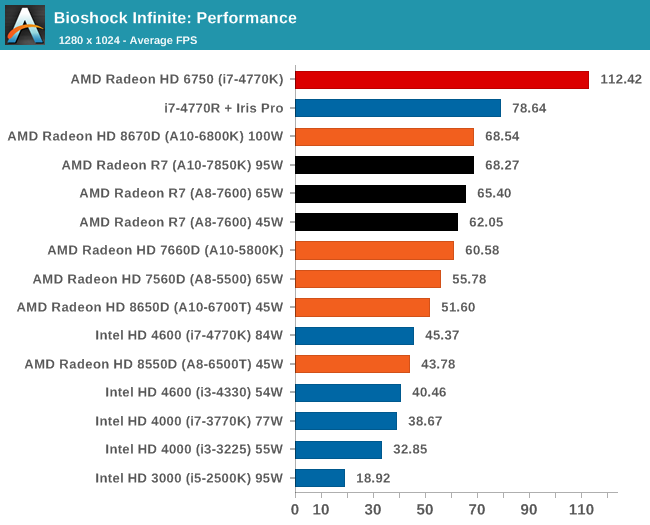
For BI: Performance we see the Iris Pro being top of the IGPs, although the next six in the list are all AMD. The Kaveri cores are all between the 6800K and 5800K for this test, and all comfortably above 60 FPS average.
Bioshock Infinite, Quality Settings

For the quality settings, the Iris Pro starts to struggle and all the R7 based Kaveri APUs jump ahead of the A10-6800K - the top two over the Iris Pro as well.
Bioshock Infinite, Xtreme Settings
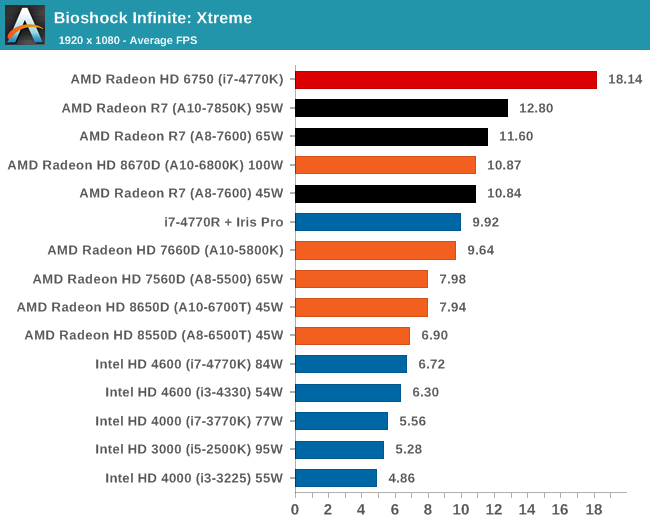
The bigger the resolution, the more the Iris Pro suffers, and Kaveri takes three out of the top four IGP results.
Integrated GPU Performance: Tomb Raider
The second benchmark in our test is Tomb Raider. Tomb Raider is an AMD optimized game, lauded for its use of TressFX creating dynamic hair to increase the immersion in game. Tomb Raider uses a modified version of the Crystal Engine, and enjoys raw horsepower. We test the benchmark using the Adrenaline benchmark tool and their three default settings of Performance (1280x1024, Low), Quality (1680x1050, Medium/High) and Xtreme (1920x1080, Maximum) noting down the average frame rates and the minimum frame rates.
Tomb Raider, Performance Settings
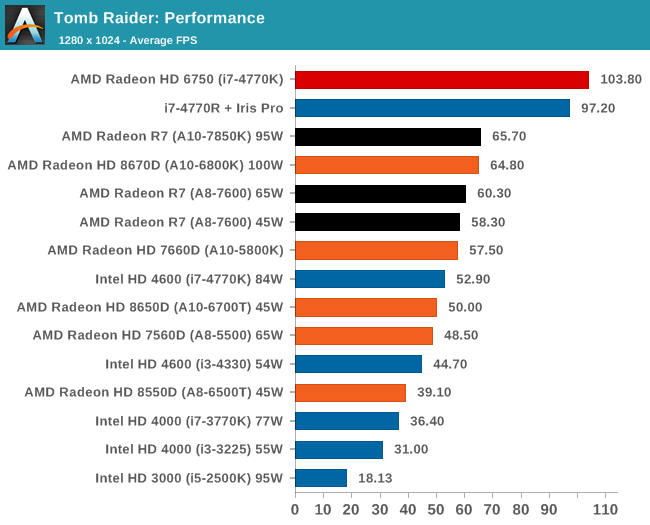
The top IGP for Richland and Kaveri are trading blows in TR.
Tomb Raider, Quality Settings

The Iris Pro takes a small lead, while the Kaveri 95W APU show little improvement over Richland. The 45W APU however is pushing ahead.
Tomb Raider, Xtreme Settings
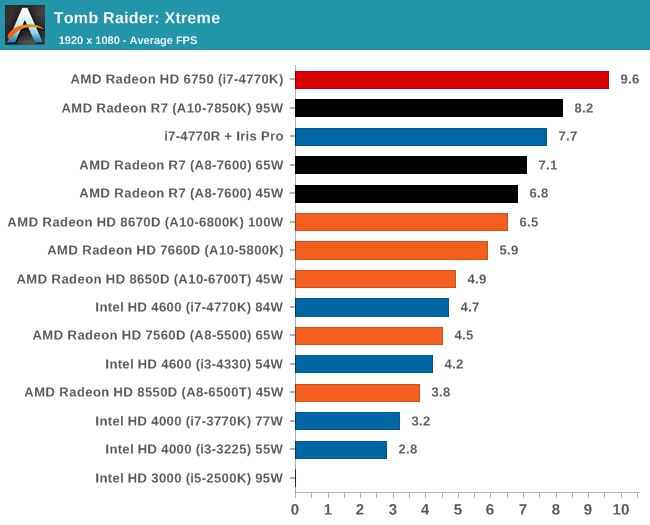
At the maximum resolution, the top Kaveri overtakes Iris Pro, and the 45W Kaveri it still a good margin ahead of the A10-6700T.
Integrated GPU Performance: F1 2013
Next up is F1 2013 by Codemasters. I am a big Formula 1 fan in my spare time, and nothing makes me happier than carving up the field in a Caterham, waving to the Red Bulls as I drive by (because I play on easy and take shortcuts). F1 2013 uses the EGO Engine, and like other Codemasters games ends up being very playable on old hardware quite easily. In order to beef up the benchmark a bit, we devised the following scenario for the benchmark mode: one lap of Spa-Francorchamps in the heavy wet, the benchmark follows Jenson Button in the McLaren who starts on the grid in 22nd place, with the field made up of 11 Williams cars, 5 Marussia and 5 Caterham in that order. This puts emphasis on the CPU to handle the AI in the wet, and allows for a good amount of overtaking during the automated benchmark. We test at three different levels again: 1280x1024 on Low, 1680x1050 on Medium and 1920x1080 on Ultra. Unfortunately due to various circumstances we do not have Iris Pro data for F1 2013.
F1 2013, Performance Settings
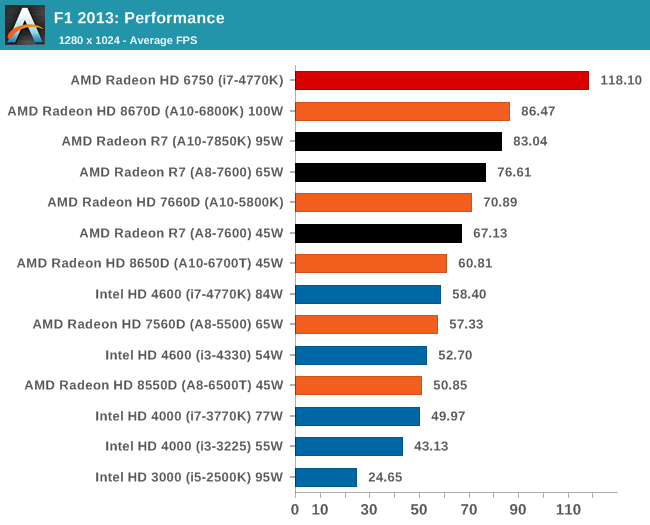
F1 likes AMD here, although moving from Kaveri to Richland at the high end seems a bit of a regression.
F1 2013, Quality Settings
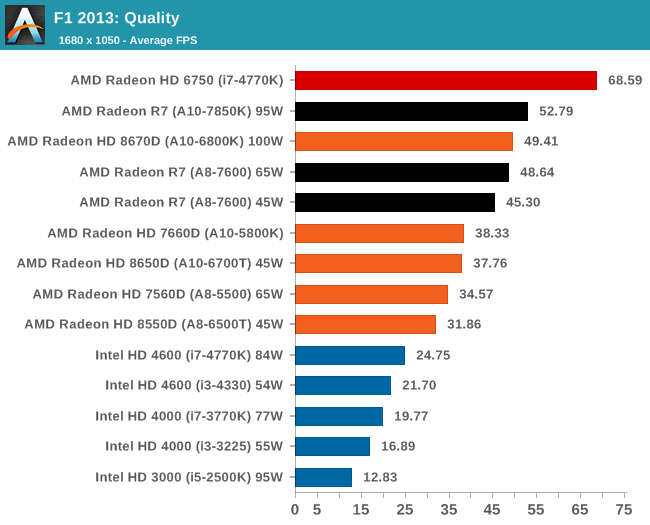
Similarly in the Quality settings, none of the Intel integrated graphics solutions can keep up with AMD, especially Kaveri.
F1 2013, Xtreme Settings

On extreme settings, at 1080p, the top Kaveri APU manages to hit over 30 FPS average during the benchmark. The other A8 Kaveri data is not too far behind.










380 Comments
View All Comments
DryAir - Tuesday, January 14, 2014 - link
So at playble settings (30 fps+) kaveri is no better than richland. And both get outperformed by Iris Pro.jeffkibuule - Tuesday, January 14, 2014 - link
That CPU with Iris Pro costs $450 compared to these AMD chips which are far less expensive.takeship - Tuesday, January 14, 2014 - link
Only if you spring for the i7 variant. The i5 variant is ~300$. Still a premium over Kaveri, but you're also getting nearly double the CPU power.mr_tawan - Tuesday, January 14, 2014 - link
Also Iris comes only with R-variant of i5/i7. It won't run on your mainboard, so forget about DIY machine. You can always get a dGPU for that kind of machine though.just4U - Tuesday, January 14, 2014 - link
Is that why you can't buy the R variant at the usual places? I wasn't even aware that they are not compatible with regular 1150 boards.. hmmm.. that's to bad. I just thought they were in low supply or going to OEMs before they hit the retail channels.Gigaplex - Wednesday, January 15, 2014 - link
I'm pretty sure they only come in soldered-on variants.Klimax - Friday, January 17, 2014 - link
Correct, however some rumors say, that it won't be case with Broadwell/Haswell-refresh anymore. (Depends who is correct)thevoiceofreason - Tuesday, January 14, 2014 - link
Precisely. All those percentage improvement at 1080p graphs look very nice but are in the end moot if you realize you are looking at 12fps.At the end of the day, you can barely play at 720p.
methebest - Tuesday, January 14, 2014 - link
he needed to test them on low settings at 1080p.Principle - Tuesday, January 14, 2014 - link
Thats because they dont do these APUs any justice with their review strategy. They basically want to push GPUs, so they do not highlight the APU's actual capabilities. For example, how about some qualitative subjective analysis, rather than all of this easily comparative quantitative nonsense. I want to know at 1080p, what settings have to be turned down to be playable. Why in the world would they run these at Extreme settings??? Its absurd, unless you're trying to sell dGPUs. Where the AMD solutions really have an advantage is in the details. You likely can turn off AA and see the AMD FPS double, without nearly as big of jump by the Intel IGP where you would likely have to turn everything off or on low.